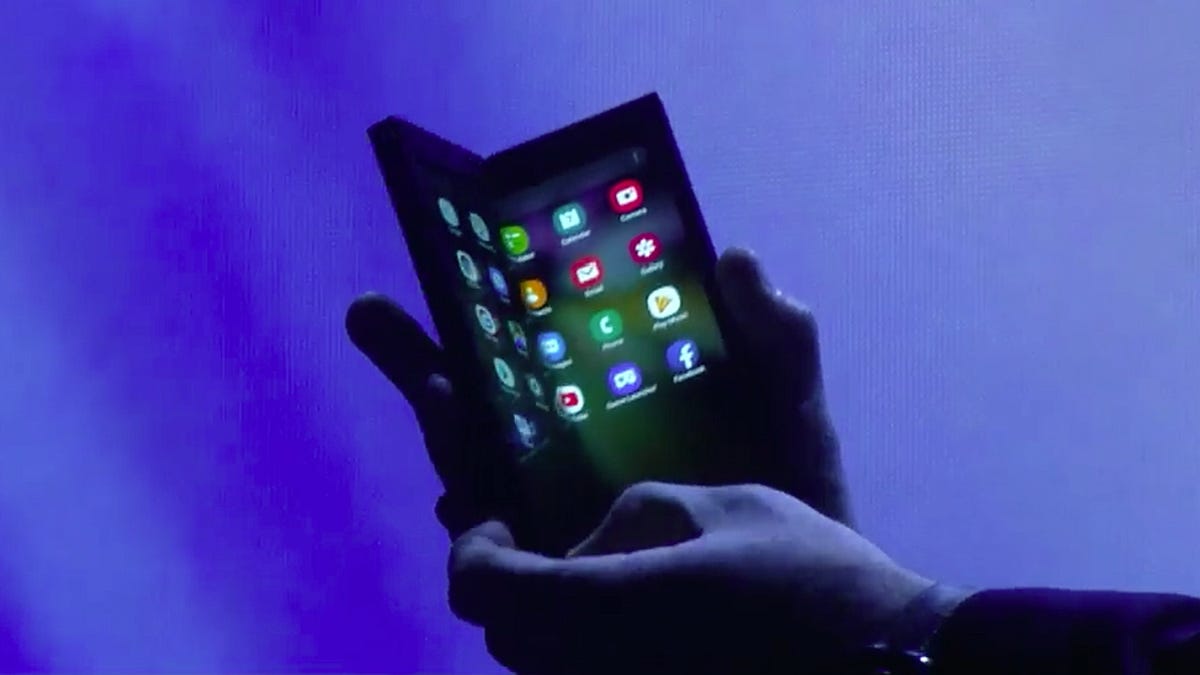For Samsung's foldable phone, killer apps would seal the deal
To elevate this device beyond gimmick territory, Samsung needs apps you can't live without.

Here's Samsung's foldable smartphone.
Samsung's
much-hyped foldable smartphone is indeed real. We all got a brief (and dimly lit) glimpse of it earlier this week. Sometime next year, Samsung says, it'll hit the market.
So now what?
Smartphones with foldable displays could represent the next big leap in mobile technology, an innovation that'll finally get us excited about the category again. (Need something soon? Coming in December from a small startup is the developer's version of a foldable phone called the Royole FlexPai.) Because let's face it, after a year in which most of the flagship smartphones got just minor upgrades -- and notches -- we could all use a little change.
The coming months will be critical for Samsung as it readies the product for consumers. But just as important will be how developers take advantage of the unique design, which rocks a smaller front screen, but opens up like a book to reveal a larger, tablet-like display.
That's why Samsung chose to unveil the device at its annual developer conference. Those programmers will be critical to making sure the foldable display is more than a gimmick.
Samsung did not want to give this phone the full spotlight treatment.
"When we deliver a foldable phone, it has to be really meaningful to our customer," said D.J. Koh, head of Samsung's mobile business, in an interview on the sidelines of the Galaxy A9 launch last month. "If the user experience is not up to my standard, I don't want to deliver those kind of products."
Samsung wasn't available to comment on the phone beyond what was said at the presentation Wednesday.
It doesn't hurt that the technology has the backing of Google, which has pledged that Android will support foldable devices. Speaking this week, Dave Burke, Google's Android vice president of engineering, said he expects to see foldable devices from several different Android manufacturers.
So how exactly will people make use of the bigger display and the two screens? While the killer app may still be percolating in some savvy developer's head, here are a few early ideas for how you can take advantage of Samsung's purported "Galaxy F."
More screen
The most obvious benefit is the larger tablet display, which gives you a better video viewing experience, or more screen real estate to read a book. Ross Rubin, an analyst at Reticle Research, thinks larger apps written for tablets would do well on the larger canvas.
Carolina Milanesi, an analyst at Creative Strategies, doesn't think a killer app is necessary -- the tablet-like display is the key selling point. If Samsung includes an S-Pen stylus, the larger display should make for an ideal sketchbook.
"If you look at the past few years, it looks like consumers never have enough screen," Milanesi said.
Multitasking
Justin Denison, senior vice president of mobile market for Samsung, touted the smartphone's ability to handle three apps at once, a feature called "Multi Active Window."
Having the extra large display could let you live-tweet while watching live sports, or coordinate a meeting spot with a friend on Facebook Messenger while Google Maps is up. Or you could take notes while browsing or on a videoconference call.
This could theoretically replace a laptop, with half the screen serving as a large virtual keyboard and Microsoft Word taking up the top half.
"The notion of only putting this device in my pocket and not having to carry a backpack seems very attractive," said Patrick Moorhead, an analyst at Moor Insights.
Better gaming
Along those lines, a larger display with two windows open could create a better gaming experience. Half the display could run Fortnite , while the other half has a chat window up with your teammates.
"Maps and media and gaming – if game developers optimize for the form factor – are certainly going to be more immersive," said Avi Greengart, an analyst at Global Data.
Multiuser experience
While the ZTE Axon M turned out to be more a weird experiment than a game changer, the "foldable" phone did demonstrate how a display that folds out could lend itself to new experiences.
The ZTE Axon M also has a foldable design, although the border in the middle ruins the illusion it's one seamless display.
The Axon M employs two displays -- one in the front and a second in the back -- that fold out to form a larger single display (albeit with an unsightly border running down the middle) -- so the design is different from Samsung's.
But the Axon M showed off different applications that enabled two players to participate, taking advantage of the separate screens when it was folded down. One was a Battleship-like game that let two players access the separate screens. Another was a camera app that had video or images of a cute animal on the front-facing display to attract your child's attention for that perfect photo.
Samsung doesn't employ a screen that folds out, but its own smaller front-facing display could be a second screen for multiplayer applications.
An evolution of devices
Getting consumers to embrace foldable smartphones could lay the foundation for more devices using flexible displays. Mark Hung, an analyst at Gartner, sees smartphones as a stepping-stone device to wrist-worn devices and beyond, including displays implanted directly onto clothing, headwear and accessories.
"I expect that they'll find more uses in wearable designs," Hung said.
CNET's Holiday Gift Guide: The place to find the best tech gifts for 2018.
Best Black Friday 2018 deals: The best discounts we've found so far.

